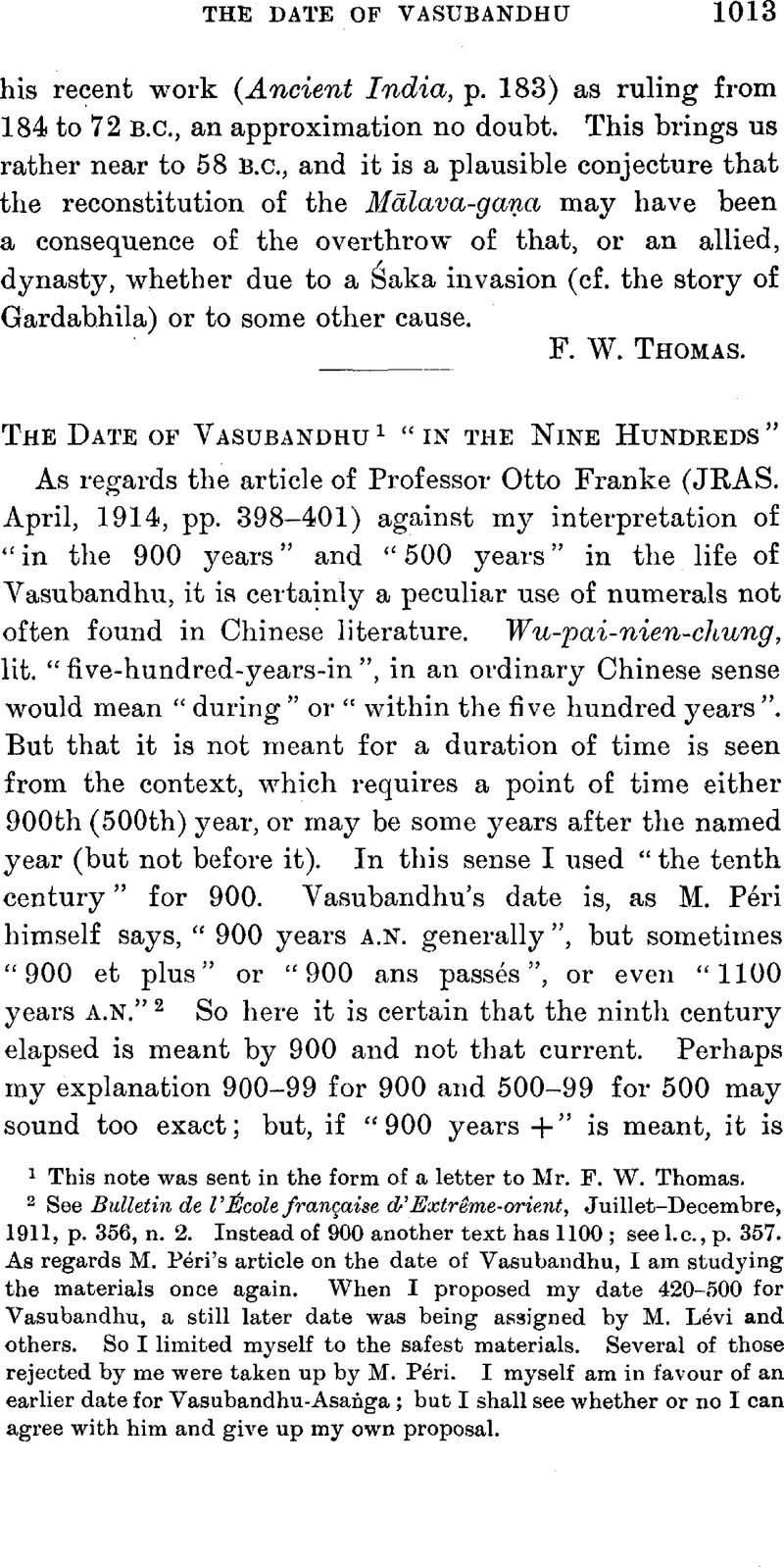No CrossRef data available.
Article contents
The Date of Vasubandhu1 “in the Nine Hundreds”
Published online by Cambridge University Press: 15 March 2011
Abstract

- Type
- Miscellaneous Communications
- Information
- Copyright
- Copyright © The Royal Asiatic Society 1914
References
page 1013 note 2 See Bulletin de l'École française d'Extrême-orient, Juillet-12, 1911, p. 356, n. 2.Google Scholar Instead of 900 another text has 1100; see l.c., p. 357. As regards M. Péri's article on the date of Vasubandhu, I am studying the materials once again. When I proposed my date 420–500 for Vasubandhu, a still later date was being assigned by M. Lévi and others. So I limited myself to the safest materials. Several of those rejected by me were taken up by M. Péri. I myself am in favour of an earlier date for Vasubandhu-Asaṅga; but I shall see whether or no I can agree with him and give up my own proposal.
page 1014 note 1 In Japanese, if we say Go-hyaku-nen-dai (![]() ), lit. “in the five hundreds”, it means exactly the period of 500–99. Further, if we say Go-hyaku-go-ju-nen-dai (
), lit. “in the five hundreds”, it means exactly the period of 500–99. Further, if we say Go-hyaku-go-ju-nen-dai (![]() ), it is for the period of 550–9, just as you say “in the fifties”, “sixties”, or “seventies” of the current century. I think that this ought to be also the Chinese custom, if any era or dynasty lasts so many hundreds or thousands of years. Unfortunately, no era being in use in China, I cannot adduce any evidence for this.
), it is for the period of 550–9, just as you say “in the fifties”, “sixties”, or “seventies” of the current century. I think that this ought to be also the Chinese custom, if any era or dynasty lasts so many hundreds or thousands of years. Unfortunately, no era being in use in China, I cannot adduce any evidence for this.
page 1014 note 2 Wassilief, , Buddhismus, pp. 238, 240.Google Scholar
page 1014 note 3 [Cf. my remarks supra, p. 749.—F. W. T.]
page 1014 note 4 Nanjio Cat., Nos. 1284, 1285, 1286; Wassilief, , l.c., p. 244.Google Scholar
page 1014 note 5 Nikkhante paṭhame vassasate (Dīp. 5. 16).Google Scholar
page 1015 note 1 Samantapāsādikā, p. 294.Google Scholar
page 1015 note 2 Dutiye vassasatantare (Dīp. 5. 53).Google Scholar
page 1015 note 3 Or these may be dvi-varṣaśate, tri-varṣaśateṣu, caturṣu varṣaśateṣu, or something like these, as we find in some inscriptions. See Bombay Archœological Report, 03, 1913, pp. 58–9.Google Scholar
page 1015 note 4 Wassilief, , l.c., pp. 249, 251, 252, 255.Google Scholar
page 1015 note 5 Ti is the sign of an ordinal.
page 1015 note 6 Especially the latter part of the book, which corresponds to Vasumitra's work.
page 1015 note 7 The list is not quite clear on some points; therefore I add the whole list at the end for a reference.
page 1016 note 1 The text has 300 years, but we have to read “the third 100 years” from the context.




